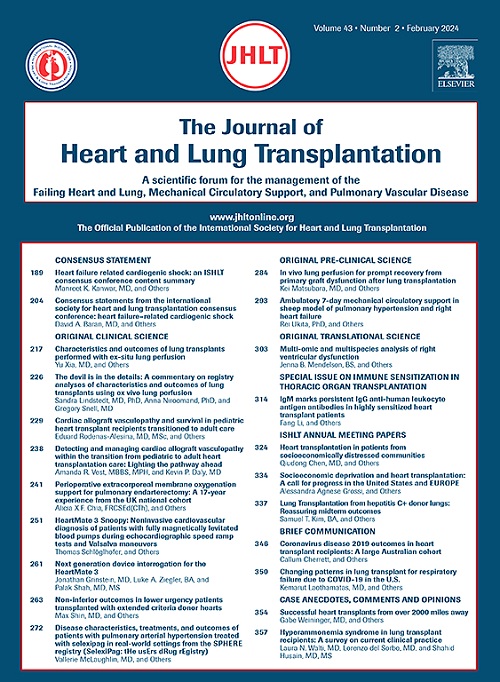A systematic review of reporting and handling of missing data in observational studies using the UNOS database
IF 6
1区 医学
Q1 CARDIAC & CARDIOVASCULAR SYSTEMS
引用次数: 0
Abstract
Background
Missing data decreasing study power and introducing bias, thereby undermining a registry’s ability to draw valid inferences. We evaluated how missing data are reported and addressed in heart transplantation (HT) studies using the United Network for Organ Sharing (UNOS) database.
Methods
We conducted a systematic literature search of Medline from January 1, 2018 through August 22, 2023 and included studies that used the UNOS database to evaluate adult (≥18 years) de novo HT recipients. We collected details on the study population, timeframe, primary end-point, use of missing data, and whether and what methods were used to handle missing data. Approaches were classified as variable selection, complete case analysis (CCA), missing indicator method, single imputation, or multiple imputation.
Results
Of the 229 included studies, 67 (29.3%) limited their cohorts to those without missing data for the outcome or key variables and 93 (40.6%) reported missing data in their final cohort. 78 (34.1%) studies reported how they handled missing data in their statistical modeling. Of these, CCA was most used (n = 41, 52.6%) followed by multiple imputation (n = 22, 28.2%), and other methods (n = 15, 19.2%). Thirty-one (13.5%) studies reported removing covariates from their analysis because of missingness.
Conclusions
Merely a third of the identified UNOS database studies reported how they handled missing data in their analysis, with strategies varying. Although no singular approach to handling missing data exists, methods are available that can improve upon the most used approaches. Future best practices should include explicit reporting of missingness, detailed methods, and sensitivity checks.
使用 UNOS 数据库对观察性研究中缺失数据的报告和处理进行系统回顾。
背景:缺失数据会降低研究能力并带来偏倚,从而削弱登记处得出有效推论的能力。我们利用器官共享联合网络(UNOS)数据库评估了成人心脏移植(HT)受者观察性研究中如何报告和处理缺失数据:我们对2018年1月1日至2023年8月22日期间的Medline进行了系统性文献检索,纳入了使用UNOS数据库评估成人(≥18岁)心脏移植新受者的研究。我们收集了有关研究人群、时间框架、主要终点、缺失数据的使用以及是否和使用何种方法处理缺失数据的详细信息。方法分为变量选择、完整病例分析(CCA)、缺失指标法、单项归因或多项归因。结果:2018-2023年共纳入229项研究。67项(29.3%)研究将其队列限定为结果或关键变量无缺失数据的研究,93项(40.6%)研究报告了其最终队列中的缺失数据。78项(34.1%)研究报告了在统计建模中如何处理缺失数据。其中,使用最多的是 CCA(n=41,52.6%),其次是多重归因(n=22,28.2%)和其他方法(n=15,19.2%),包括缺失指标法(二元变量)和单一归因的组合。有 31 项(13.5%)研究报告称,由于数据缺失,他们在分析中删除了协变量。只有四项(5.1%)研究报告了敏感性分析,以评估不同的缺失数据方法:结论:在已确定的 UNOS 数据库研究中,仅有三分之一的研究报告了他们在分析中处理缺失数据的方法,而且策略各不相同。虽然不存在处理缺失数据的单一方法,但有一些方法可以改进最常用的方法,例如减少偏差和提高统计能力。尽管这些改进取决于缺失数据机制和分析目标。未来的最佳做法应包括明确报告缺失情况、详细方法和敏感性检查,以最大限度地提高 UNOS 数据库分析的可信度。
本文章由计算机程序翻译,如有差异,请以英文原文为准。
求助全文
约1分钟内获得全文
求助全文
来源期刊
CiteScore
10.10
自引率
6.70%
发文量
1667
审稿时长
69 days
期刊介绍:
The Journal of Heart and Lung Transplantation, the official publication of the International Society for Heart and Lung Transplantation, brings readers essential scholarly and timely information in the field of cardio-pulmonary transplantation, mechanical and biological support of the failing heart, advanced lung disease (including pulmonary vascular disease) and cell replacement therapy. Importantly, the journal also serves as a medium of communication of pre-clinical sciences in all these rapidly expanding areas.

 求助内容:
求助内容: 应助结果提醒方式:
应助结果提醒方式:


